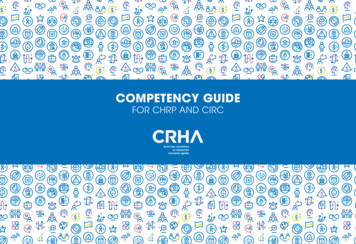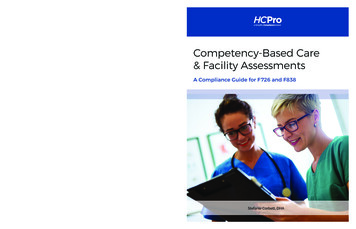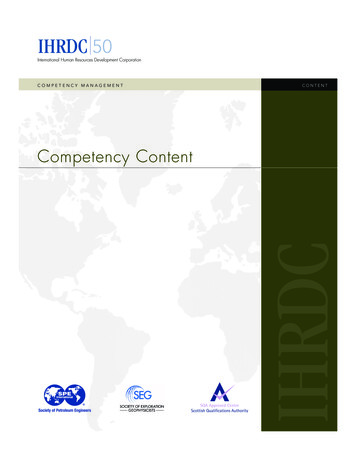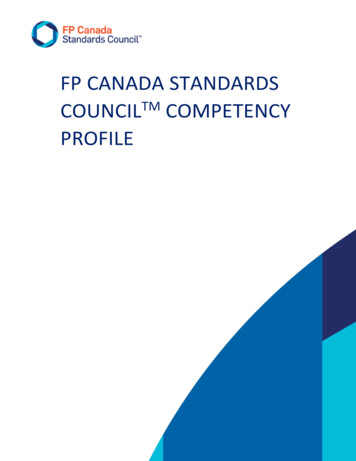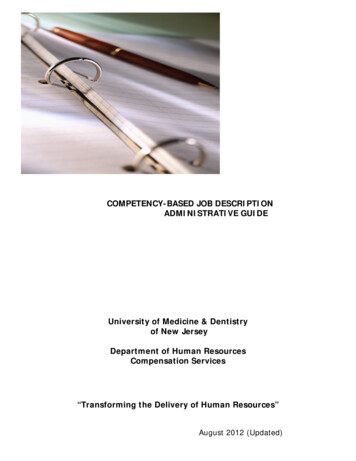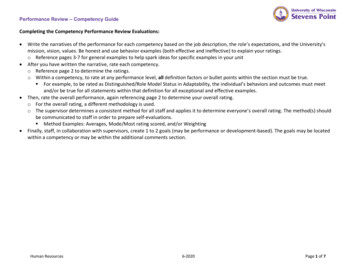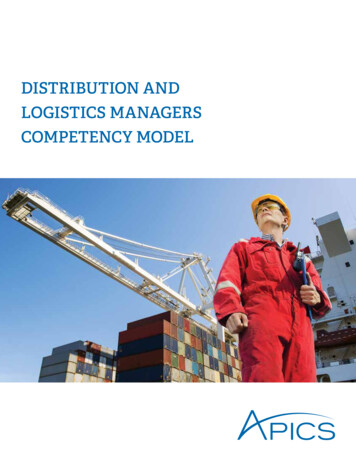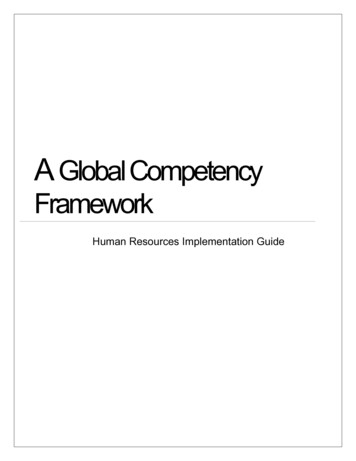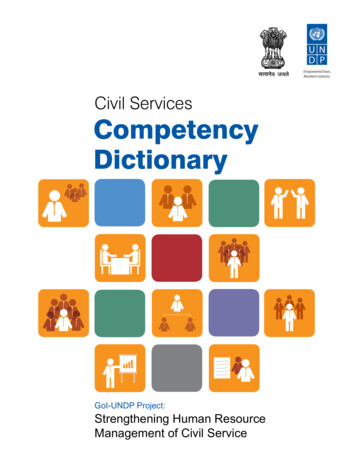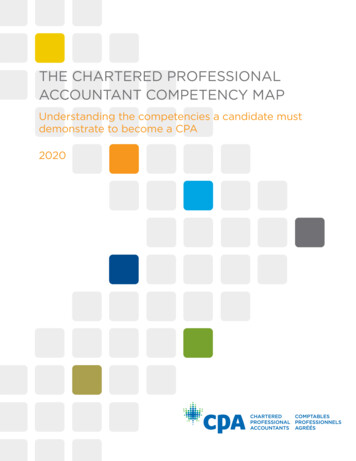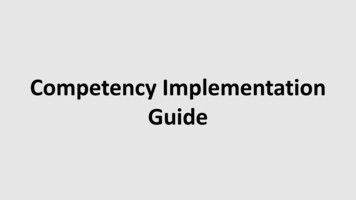
Transcription
Competency ImplementationGuide
Purpose of This Tool:This tool will assist you with understanding and implementing competencies inyour organization.The tool will: Introduce you to competencies Definition of a competency Anatomy of a competency Benefits of using competencies in your organization Competency types Explain how to implement and use competencies in your organization forlearning and development purposes2
Competencies, A General Overview3
General Overview:What are Competencies?Competencies - encompass knowledge, skills, and abilities (KSAs) combined with relevant personalcharacteristics to successfully perform in your job/role.TechnicalWHAT .you need toknowHOWBehavioral .you applywhat you knowCompetencies describe the observable, measurable, key behaviors or actions that can be seen when a jobis being done.4
General Overview:Anatomy of a CompetencyA competency has three parts: Title, Definition, Key ates a commitment to public service; serves and satisfiesinternal and external customers; holds self accountable for qualityoutcomes.Key Behaviors: Establishes and maintains credibility with the public, partners, customers, and co-workers.Works with customers to assess their needs.Takes specific actions to meet/exceed customer requirements and expectations.Conveys a positive attitude when interacting with customers and staff.Identifies opportunities to improve customer service and satisfaction.Key behaviors are examples of observable actions that an employee could be expected todemonstrate in successfully performing his/her work.5
General Overview:Benefits of Using Competencies in your OrganizationCompetencies offer multiple benefits to an organization and its workforce.BenefitDefine CapabilitiesClarify ExpectationsSupport LearningImprove ConversationsIdentify Realistic GoalsIncrease AwarenessSustain the OrganizationSupport Management ofEmployees(Manager’s Toolkit)How?Provides a common language for describing workforce needs as they relate to the mission andstrategic objectives of the organization.Establishes and communicates expectations for the specific behaviors that contribute to successfuljob performance.Encourages employees to be accountable for their professional development; Focuses learning onclearly identified development needs.Provides a baseline and opens the door for professional development and performance conversationsbetween employees and supervisors.Identifies strategic, targeted and realistic learning and development objectives/needs.Promotes understanding of the competencies expected for a move into a new job; includingbecoming supervisors/managers or changing careers.Identifies strategic, targeted and realistic learning and development objectives/needs to support astrongly sustaining organization with a defined succession strategy.Managers can use Competencies to:Identify minimum requirements for new hires (interviewing tool); Articulate and standardizeexpectations; Capture knowledge from retiring employees; and Focus staff on selected aspects ofperformance to achieve the mission and organization’s objectives.6
General Overview:Additional Benefits of CompetenciesBenefits for the Organization: Ensures that organization-funded training and professional development activities are cost-effective, goal-oriented, productive, and are approachedin a systematic manner Establishes expectations for performance excellence Defines what success looks like Can reduce potential turnover caused by miscommunication of job expectations Improves communication between employee and supervisors Can promote internal employee mobility Establishes a framework for constructive feedback by supervisors Outlines employee development and promotional paths within the organization Reinforces organizational strategy, culture, and visionBenefits for the Employee Sets clear performance expectations for employees, enabling them to make better decisions and work more effectivelyGives employees insight into the overall strategy of their team, department, and organization, leading to greater engagement and motivationEnables employees to be more proactive beyond their individual roles, by learning additional competencies that are valued by the organizationProvides clear direction for learning new job skillsOffers a reference resource for day-to-day requirementsIncreases the potential for job satisfactionProvides a mechanism for the recognition of employees’ abilitiesSupports a more specific and objective assessment of their strengths and specify targeted areas for professional developmentProvides the basis for a more objective dialogue with their manager or team about performance, development, and career related issues.7
General Overview:Competency TypesLeadershipExecutive sLeadership CoreIC wide applicable toall employees in allroles.8
General Overview:Competency Types, Cont. Core Competencies: Support the Institute/Center’s desired culture and promotes the mission/vision of the entire organizationRequired of all employees regardless of job functionRepresent the knowledge, skills, and abilities required of all employees to perform in any occupation and/or functionDetermined by Senior/Executive leadership of the Institute/Center Technical Competencies: Represent the skill sets required for specific functional areas Are the very specific skills related to the technical demands of the organization that help you complete your specific tasks Are the competencies related to “what gets done” Non-Technical Competencies Are the “softer” behavioral/cognitive skills needed to be successful in your role Not directly related to the control of technical proficiency Help define and drive cultural and interpersonal aspects of work behavior Foundational competencies such as “Accountability” and “Leveraging Technology” which can be applied across any or alloccupations Are the competencies related to “how things get done”9
General Overview:Competency Types, Cont. Leadership and Management Competencies: Represent the essential competencies necessary to be a successful and effective leader and/or manager within theInstitute/Center Based on “official” position of leadership within the organization Office/Division Directors Branch Chiefs Team Leads Executive Level Proficiencies: These proficiencies are designed to identify the skill sets of the top levels of management and can be used as aguide for individuals aspiring to reach these positions (e.g., IC Director, Deputy IC Director, Scientific Director,Extramural Director, or Executive Officer).Based on “official” position of leadership within the organization10
General Overview:Potential Applications of Competencies Individual and Organizational Learning and Development (most common use of competencies at NIH) Validation of competency models/lists that define success in a given role/job function Self and supervisory competency assessments Individual Development Plans (IDPs) resulting from competency assessment results Organizational learning strategies Workforce Planning Defining the work performed at the Institute/Center Improving operations and effectiveness (clarifying roles/expectations and work norms, driving culture) Workforce Skills Inventory and Gap Analyses Outlining the ranges of competency proficiency levels within each job function and determining where gaps reside Succession and Transition Planning Competencies-based skills inventory can tell leaders and managers about the capabilities and readiness of the pipeline of potential candidatesto fill key positions in the future Can be used to develop a bench strength (depth chart) report and action plan for development and Succession & Transition Planning purposes Recruiting/Interviewing Assess if candidates demonstrate levels of proficiency in the competencies needed for defining success in a role or job function for which isbeing hired for Identify minimum requirements for new hires Articulate and standardize expectations11
Implementing Competencies in YourOrganization for Employee Learning andDevelopment12
Implementing Competencies in your Organization:High-Level ProcessSelect a pre-developedNIH model or buildyour own modelEmployee pursuesapproved learningactivities as outlined inIPDStep8Employee createsIndividual LearningPlan (IDP)Step7Post assessmentconversations betweensupervisor and ors assessdirect reportsValidate the modelwith SMEs(See “NIH Competency ValidationToolkit”)Introduce model to theemployee populationEmployees conductself-assessment13
Implementing Competencies in Your Organization:Step 1: Select a Pre-Developed NIH Model or Build Your OwnNIH has a wide array of suggested pre-existing competency models which areavailable by visiting the NIH Competency Site by clicking here.If building a new model, use the NIH Competency Dictionary as a guide toanalyze source documents such as PD’s, job analyses, job announcements, jobassessment questions, PMAPs: Identify the Non-Technical competencies that are essential for the position (as a rule ofthumb you should have no more than 9 non-technical competencies) Identify the Technical competencies that are essential for the position Include your Institute/Center’s Core competencies if applicable If the position entails supervisory duties you can also consider the leadership andmanagement competencies14
Implementing Competencies in Your Organization:Step 1: Things to Consider if Building a New Model Does the model include the particular competencies needed for staff to successfullyperform the work in the job role? How will the work of staff in this job function change in the future? What will this meanfor the types of competencies staff will need in order to perform at high levels? Consider high performers (in and outside of the organization). What differentiates them?What makes them successful? What would you look for in a new hire; what are those characteristics critical for successin the position? Keep the model manageable. While it can be easy to include many competencies, onlyinclude the ones that are essential to describing what success looks like in the job role. Focus on the behaviors rather than the tasks and avoid a lot of specificity about tasks thatcan change frequently over time15
Implementing Competencies in Your Organization:Step 1: Sample Competency Model16
Implementing Competencies in Your Organization:Step 2: Validate the Model with Subject Matter Experts (SMEs)Whether you are using a pre-existing NIH model or developing a new one, it isimportant to validate the model with SMEs to ensure the model depicts the necessarycompetencies needed to be successful in the job role now and into the future.A small group of top performing SMEs should be asked to review the model andconsider the following questions: Does the model include the particular competencies needed for staff to successfully performthe work? How will the work of staff in this job change in the future? What will this mean for the types ofcompetencies staff will need to be successful? Consider top performers (in and outside of the organization). What differentiates them? Whatmakes them successful? What would you look for in a new hire; what are the characteristics critical for success in theposition? Are the definitions clear for staff to rate how proficient they are in each competency? Andguide development? Is anything missing from the model?17
Implementing Competencies in Your Organization:Step 3: Introduce the Model to the Employee PopulationNow that the model has been validated by SMEs, introduce the model througha kick-off meeting to all employees in the organization. Discuss how the modelwill be used (typically to enforce the culture and drive learning anddevelopment activities) and outline the next steps in the process.Introduce the SME validation group so all employees can see that that themodel was validated by their peers and so they can also have a chance to askquestions about the model and/or how it was validated/developed.Explain that employees will be asked to assess their perceived levels ofproficiency against competencies in the model and that their supervisor willalso be assessing them against each of the competencies in the model.Emphasize that the purpose of this process is to guide individual andorganizational learning and development activities and is not tied to theirPMAP assessment.18
Implementing Competencies in Your Organization:Step 4: Employees Conduct Self-AssessmentUsing the NIH Proficiency Scale, the competency definitions, and key behaviors,employees should assess their perceived level of proficiency against eachcompetency in the model.This self-assessment can be completed electronically in the LMS by followingthe NIH LMS competency user guides, by using a simple excel tracker, or simplyby writing proficiency levels on a sheet of paper next to each competency in themodel.It is important to remind employees that the NIH Proficiency Scale is NOT tiedto the PMAP rating scale and that employees should be open and honest whenassessing themselves.Remind employees that the results of the self-assessment, when combinedwith other relevant information (e.g., organizational priorities, team needs,supervisory feedback), will support an employee and the organization inidentifying their strengths and development needs.19
Implementing Competencies in Your Organization:Step 4: Proficiencies and the NIH Proficiency ScaleProficiency - The ability to apply or demonstrate a competency on the job.The NIH defines proficiencies using a rating scale with 5 levels: (see appendixfor detailed description of each level)1 - Fundamental Awareness (basic knowledge)2 - Novice (limited experience)3 - Intermediate (practical application)4 - Advanced (applied theory)5 - Expert (recognized authority)Employees and supervisors will use the NIH proficiency scale to assess theirperceived level of proficiency on each of the competencies in the competencymodel.20
Implementing Competencies in Your Organization:Step 5: Supervisors Assess Their Direct ReportsUsing the NIH Proficiency Scale, the competency definitions, and key behaviors,supervisors should assess each direct reports’ level of proficiency against eachcompetency in the model.The supervisory-assessment can be completed electronically in the LMS byfollowing the NIH LMS competency user guides, by using a simple excel tracker, orsimply by writing the proficiency levels on a sheet of paper next to eachcompetency in the direct report’s model.There may be times when a supervisor may not have had the chance to observean employee demonstrating a competency but that’s okay; this can be a topic ofconversation during the post assessment conversation with the direct report.It is important to remind supervisors that this is not a PMAP activity and thatthey are assessing their direct reports’ levels of proficiency against a competency.Remind supervisors that they will have an opportunity to meet with each directreport to discuss their ratings during the post assessment meetings.21
Implementing Competencies in Your Organization:Step 6: Post Assessment Conversations Between Supervisor and Direct ReportAfter the self and supervisor assessments are complete, supervisors shouldschedule one on one meetings to discuss the results of the assessments.During these meetings supervisors and employees should come together toreview the proficiency ratings for each competency and discuss where strengthscould be leveraged and where there may be opportunities for development.The employee’s and supervisor’s proficiency assessment ratings for eachcompetency may not be the same; if this is the case there should be a candiddiscussion around the difference of opinions to better understand the reasoningbehind each rating.These conversations will help both the supervisor and employee to betterrecognize where strengths can be capitalized upon and will provide a platform todiscuss where there are opportunities for development, all of which will help theemployee create a meaningful IDP.22
Implementing Competencies in Your Organization:Step 6: Post Assessment Conversations Between Supervisor and Direct ReportThis is a meeting with the supervisor and employee to discuss competency assessment resultsand proficiency scores.During the meeting: Discuss the employee’s assessment scores vs supervisor’s scores Where are there differences in scores? How big are the differences (gaps)? Is there a common understanding of the competency? Have a candid discussion to help each other better understand the basis for the assessmentscores Discuss where strengths can be leveraged Discuss where there may be opportunities for development Gain a better idea of where you need to focus your learning and development efforts and whichcompetencies you should focus on developing Establish an action plan or IDP23
Implementing Competencies in Your Organization:Step 7: Employee Creates Individual Learning Plan (IDP)Individual development plans are designed to help an individual map out theirtraining and development plan for a period of time, generally between one andfive years.Employees should use the information gathered from their post assessmentconversation with their supervisor to prioritize the competencies they want tofocus their learning activities in the short to long term.Using the NIH IDP Template employees should build their IDP.Remind employees that not all learning activities have to be training.Other examples of learning activities can include: Shadowing a leader or competency expert for a dayReading a bookParticipating in a stretch assignmentJoining a cross-functional working groupJob shadowing or rotationsInterviewing an expertMentoring and coaching24
Implementing Competencies in Your Organization:Step 7: What is an IDP?An Individual Development Plan (IDP) outlines career goals within the context of organizational objectives. It is adevelopmental "action" plan to move employees from where they are to where they would like to be or need tobe. It provides systematic steps to improve performance and build on strengths related to one’s current job, and tomeet one’s career goals. The goals of an IDP are developed by the employee with input from the supervisor. TheIDP links the individual's career interests and needs to organizational priorities. IDPs are used to help employees: Learn new skills to improve current job performance Maximize current performance in support of organizational requirements Increase interest, challenges, and satisfaction in current position Obtain competencies that can help lead to career changesAn IDP is: A developmental partnership between the employee and manager. IDP preparation involves feedback,clarification, and discussion about developmental needs, goals, and plans. Manager-employee communicationis key to the success of the IDP process. The mutual interests and concerns of the individual and theorganization must be considered in the IDP process. The IDP is a vehicle to address the needs of the employeeand the needs of the organization. The best IDPs begin with a plan to maximize current job performance. Theactivities can assist the individual in meeting both personal and organizational goals for success. A broadly defined developmental plan which may include on-the-job assignments, self-development activities,and formal classroom training. An active and ongoing process in the organization. Ideally, IDPs should be reviewed, updated, and revised everysix (6) months, or as needed.25
Implementing Competencies in Your Organization:Step 7: An IDP is NOT A performance appraisal. The IDP is not a means to formally assess the employee'sperformance. In this regard, it does not replace the performance appraisal system todetermine promotion, pay, awards, etc. A contract for training. Employees should include all training interests on an IDP. However,training is not guaranteed because it is on an IDP. Training decisions are made inaccordance with NIH's policy, priorities, and budgetary constraints. A way to clarify or revise a position description. If a position description does notaccurately describe the duties performed, this is a matter for the manager and the Officeof Human Resources to solve. A guarantee of a promotion to a higher grade. An IDP can help prepare an employee tobecome qualified for a higher graded position, but does not guarantee advancement. A panacea for manager-employee relations problems. The IDP is only one part of thecomprehensive efforts of an organization to enhance job satisfaction and cooperativework relationships.26
Implementing Competencies in Your Organization:Step 8: Employee Pursues Approved Learning Activities as Outlined in IPDOnce employees complete building their IDP, they should forward it to theirsupervisor for final approval.Once approved by their supervisor, employees should pursue the learningactivities as outlined in the IDP.The IDP is a living document and should be kept up to date on a continuous basis.As the employee completes the learning activities, they should be documented inthe IDP.27
Other Uses for the Competency Model28
Other Uses for Your Competency Model Can Include: Strategic workforce and organizational planning Identify hiring needs proactively based on competency gaps Talent pool assessment Clarifying expectations of the positon Basis for behavioral interviews Succession Planning29
Competency Resources30
Competency Resources NIH competency main page: fault.htm NIH competency dictionary: re/default.htm NIH competency FAQs: qs.htm NIH suggested competency models: cupationspecific/default.htm NIH competency proficiency scale: oficiencyscale.htm NIH competencies additional resources: sources.htm OPM competencies: nt-and-selection/assessmentstrategy/ NIAID competency page: ompetencies/Pages/default.aspx31
Appendix32
NIH Proficiency ScaleScore1Proficiency LevelFundamentalAwareness(basic knowledge)2Novice(limited experience)3Intermediate(practical application)45Advanced(applied theory)Expert(recognizedauthority)DescriptionYou have a common knowledge or an understanding of basic techniques and concepts. Focus is on learning.You have the level of experience gained in a classroom and/or experimental scenarios or as a traineeon-the-job. You are expected to need help when performing this skill. Focus is on developing through on-the-job experience; You understand and can discuss terminology, concepts, principles, and issues related to thiscompetency; You utilize the full range of reference and resource materials in this competency.You are able to successfully complete tasks in this competency as requested. Help from an expert maybe required from time to time, but you can usually perform the skill independently. Focus is on applying and enhancing knowledge or skill; You have applied this competency to situations occasionally while needing minimal guidance toperform successfully; You understand and can discuss the application and implications of changes to processes,policies, and procedures in this area.You can perform the actions associated with this skill without assistance. You are certainly recognizedwithin your immediate organization as "a person to ask" when difficult questions arise regarding thisskill. Focus is on broad organizational/professional issues; You have consistently provided practical/relevant ideas and perspectives on process or practiceimprovements which may easily be implemented; You are capable of coaching others in the application of this competency by translating complexnuances relating to this competency into easy to understand terms; You participate in senior level discussions regarding this competency; You assist in the development of reference and resource materials in this competency.You are known as an expert in this area. You can provide guidance, troubleshoot and answerquestions related to this area of expertise and the field where the skill is used. Focus is strategic; You have demonstrated consistent excellence in applying this competency across multipleprojects and/or organizations; You are considered the “go to” person in this area within NIH and/or outside organizations; You create new applications for and/or lead the development of reference and resource materialsfor this competency; You are able to diagram or explain the relevant process elements and issues in relation toorganizational issues and trends in sufficient detail during discussions and presentations, to fostera greater understanding among internal and external colleagues and constituents.33
Individual Development Plan (IDP) Example34
competency in the model. This self-assessment can be completed electronically in the LMS by following the . NIH LMS competency user guides, by using a simple excel tracker, or simply by writing proficiency levels on a sheet of paper next to each competency in the model. It is important to remind employees that the . NIH Proficiency Scale is .
